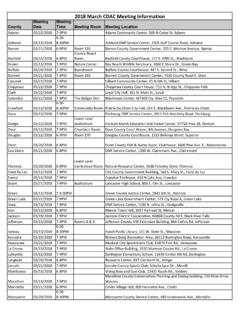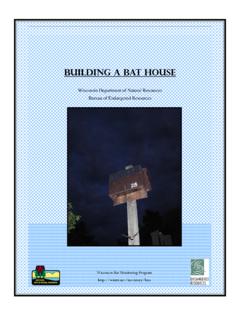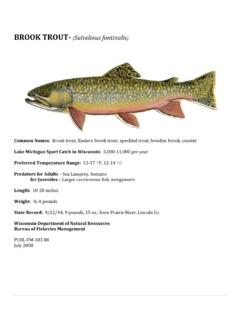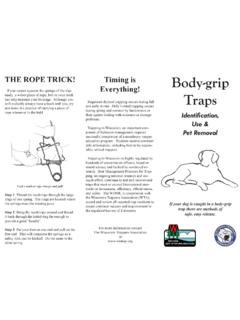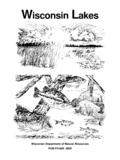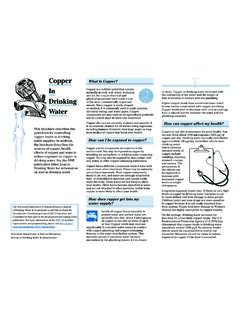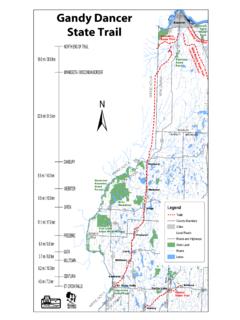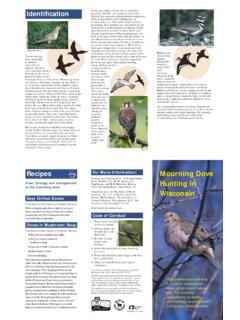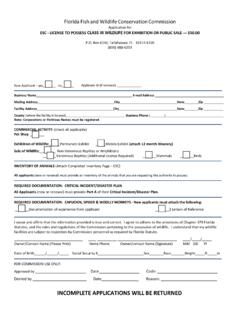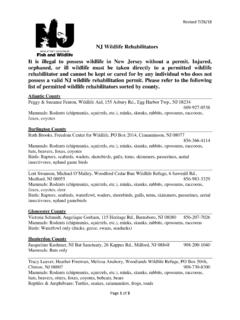Transcription of 2,4-D Fact Sheet
1 The Wisconsin Department of Natural Resources provides equal opportunity in its employment, programs, services, and functions under an Affirmative Action Plan. If you have any questions, please write to Equal Opportunity Office, Department of Interior, Washington, 20240. This publication is available in alternative format (large print, Braille, audio tape. etc.) upon request. Please call (608) 267-7694 for more information. Formulations 2,4-D is an herbicide that is widely used as a household weed-killer, agricultural herbicide, and aquatic herbicide. It has been in use since 1946, and was registered with the EPA in 1986 and re-reviewed in 2005. The active ingredient is 2,4-dichloro-phenoxyacetic acid. There are two types of 2,4-D used as aquatic herbicides: dimethyl amine salt and butoxyethyl ester.
2 Both liquid and slow-release granular formulations are available. 2,4-D is sold under the trade names Aqua-Kleen, Weedar 64 and Navigate (product names are provided solely for your reference and should not be considered endorsements nor exhaustive). Aquatic Use and Considerations 2,4-D is a widely-used herbicide that affects plant cell growth and division. It affects primarily broad-leaf plants. When the treatment occurs, the 2,4-D is absorbed into the plant and moved to the roots, stems, and leaves. Plants begin to die in a few days to a week following treatment, but can take several weeks to decompose. Treatments should be made when plants are growing. For many years, 2,4-D has been used primarily in small-scale spot treatments. Recently, some studies have found that 2,4-D moves quickly through the water and mixes throughout the waterbody, regardless of where it is applied.
3 Accordingly, 2,4-D has been used in Wisconsin experimentally for whole-lake treatments. 2,4-D is effective at treating the invasive Eurasian watermilfoil (Myriophyllum spicatum). Desirable native species that may be affected include native milfoils, coontail (Ceratophyllum demersum), naiads (Najas spp.), elodea (Elodea canadensis) and duckweeds (Lemna spp.). Lilies (Nymphaea spp. and Nuphar spp.) and bladderworts (Utricularia spp.) also can be affected. Post-Treatment Water Use Restrictions There are no restrictions on eating fish from treated water bodies, human drinking water or pet/livestock drinking water. Following the last registration review in 2005, the ester products require a 24-hour waiting period for swimming. Depending on the type of waterbody treated and the type of plant being watered, irrigation restrictions may apply for up to 30 days.
4 Certain plants, such as tomatoes and peppers and newly seeded lawn, should not be watered with treated water until the concentration is less than 5 parts per billion (ppb). Herbicide Degradation, Persistence and Trace Contaminants The half-life of 2,4-D (the time it takes for half of the active ingredient to degrade) ranges from to 40 days depending on water conditions. In anaerobic lab conditions, the half-life has been measured up to 333 days. After treatment, the 2,4-D concentration in the water is reduced primarily through microbial activity, off-site movement by water, or adsorption to small particles in silty water. It is slower to degrade in cold or acidic water, and appears to be slower to degrade in lakes that have not been treated with 2,4-D previously.
5 There are several degradation products from 2,4-D : 1,2,4-benzenetriol, 2,4-dichlorophenol, 2,4-dichloroanisole, chlorohydroquinone (CHQ), 4-chlorophenol and volatile organics. Wisconsin Department of Natural Resources2,4-D Chemical fact Sheet January 2012 Wisconsin Department of Natural Resources Box 7921 Madison, WI 53707-7921 DNR PUB-WT-964 2012 Impacts on Fish and Other Aquatic Organisms Toxicity of aquatic 2,4-D products vary depending on whether the formulation is an amine or an ester 2,4-D . The ester formulations are toxic to fish and some important invertebrates such as water fleas (Daphnia) and midges at application rates; the amine formulations are not toxic to fish or invertebrates at application rates. Loss of habitat following treatment may cause reductions in populations of invertebrates with either formulation, as with any herbicide treatment.
6 These organisms only recolonize the treated areas as vegetation becomes re-established. Available data indicate 2,4-D does not accumulate at significant levels in the bodies of fish that have been tested. Although fish that are exposed to 2,4-D will take up some of the chemical, the small amounts that accumulate are eliminated after exposure to 2,4-D ceases. On an acute basis, 2,4-D is considered moderately to practically nontoxic to birds. 2,4-D is not toxic to amphibians at application rates; effects on reptiles are unknown. Studies have shown some endocrine disruption in amphibians at rates used in lake applications, and DNR is currently funding a study to investigate endocrine disruption in fish at application rates. As with all chemical herbicide applications it is very important to read and follow all label instructions to prevent adverse environmental impacts.
7 Human Health Adverse health effects can be produced by acute and chronic exposure to 2,4-D . Those who mix or apply 2,4-D need to protect their skin and eyes from contact with 2,4-D products to minimize irritation, and avoid inhaling the spray. In its consideration of exposure risks, the EPA believes no significant risks will occur to recreational users of water treated with 2,4-D . Concerns have been raised about exposure to 2,4-D and elevated cancer risk. Some (but not all) epidemiological studies have found 2,4-D associated with a slight increase in risk of non-Hodgkin s lymphoma in high exposure populations (farmers and herbicide applicators). The studies show only a possible association that may be caused by other factors, and do not show that 2,4-D causes cancer.
8 The EPA determined in 2005 that there is not sufficient evidence to classify 2,4-D as a human carcinogen. The other chronic health concern with 2,4-D is the potential for endocrine disruption. There is some evidence that 2,4-D may have estrogenic activities, and that two of the break-down products of 2,4-D (4-chlorophenol and 2,4-dichloroanisole) may affect male reproductive development. The extent and implications of this are not clear and it is an area of ongoing research. For Additional Information Environmental Protection Agency Office of Pesticide Programs Wisconsin Department of Agriculture, Trade, and Consumer Protection Wisconsin Department of Natural Resources 608-266-2621 Wisconsin Department of Health Services National Pesticide Information Center 1-800-858-7378 2,4-D Chemical fact SheetPage 2

